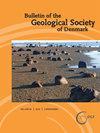丹麦陆上浅层地下热结构:温度、热导率和热流
IF 1
4区 地球科学
Q2 Earth and Planetary Sciences
引用次数: 10
摘要
丹麦陆上浅层地下热结构地下温度和热特性是控制可提取或储存在地下的热能量的重要因素。热条件的局部和区域变化会影响浅层地热装置的设计和效率,尤其是当使用热泵时(Rasmussen等人,2016;桑纳,2016年)。因此,估计地热资源和评估热提取方法需要了解温度、地下热特性以及热流。与深层地热条件相反(参见Balling等人1992、2002;Mathiesen等人2009、2010),在本研究之前,丹麦的浅层地下热条件尚未在全国范围内进行分析。第一个钻孔温度是在1900年左右作为准确的井底温度测量的(Bonnesen等人,1913),而当时丹麦陆上最深的浅层地下热结构:温度、热导率和热流本文章由计算机程序翻译,如有差异,请以英文原文为准。
Shallow subsurface thermal structure onshore Denmark: temperature, thermal conductivity and heat flow
Shallow subsurface thermal structure onshore Denmark Subsurface temperatures and thermal properties are important factors in controlling the amount of thermal energy that can be extracted or stored in the ground. Local and regional variations in the thermal conditions affect the design and efficiency of shallow geothermal installations, especially when heat pumps are applied (Rasmussen et al. 2016; Sanner 2016). Thus, knowledge about temperature, subsurface thermal properties as well as heat flow are required for estimating geothermal resources and in evaluating methodologies for heat extraction. In contrast to deep geothermal conditions (cf. Balling et al. 1992, 2002; Mathiesen et al. 2009, 2010), until the present study, the shallow subsurface thermal conditions in Denmark have not been analysed on a national scale. The first borehole temperatures were measured around 1900 as accurate bottom hole temperatures (Bonnesen et al. 1913) while the, at the time, deepest Shallow subsurface thermal structure onshore Denmark: temperature, thermal conductivity and heat flow
求助全文
通过发布文献求助,成功后即可免费获取论文全文。
去求助
来源期刊

Bulletin of the Geological Society of Denmark
GEOSCIENCES, MULTIDISCIPLINARY-
CiteScore
2.80
自引率
16.70%
发文量
28
审稿时长
>12 weeks
期刊介绍:
The Bulletin publishes contributions of international interest in all fields of geological sciences on results of new work on material from Denmark, the Faroes and Greenland. Contributions based on other material may also be submitted to the Bulletin if the subject is of relevance for the geology of the area of primary interest.
 求助内容:
求助内容: 应助结果提醒方式:
应助结果提醒方式:


